

A Biological Transistor. Scientists develop biological transistor that can command living cells. The device could tell cancerous cells to stop dividing The new device is called a "transcriptor.
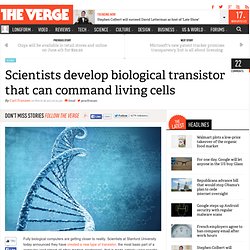
" It's a microscopic piece of a DNA molecule inside a living cell that Stanford researchers genetically engineered to control the flow of another important molecule, RNA, as though it were an electrical current. RNA is responsible for translating DNA instructions in a cell's natural processes, so by controlling it, researchers can command an entire living cell. They could tell cancerous cells to stop dividing after they reach a certain number, or turn plant cells into sensors for monitoring the environment, as one scientist involved in the work told The Independent. The transcriptor can also be used to build more efficient types of circuits than are possible using all synthetic materials.
The researchers released some of their blueprints under a public domain license, which they hope will be used by other scientists to help speed up work on the overall goal of building a complete biocomputer. Scientists create transistor-like biological device. E coli is one of the most common bugs used in genetic engineering.

Photograph: Getty Scientists have used biological tissue to recreate one of the main components of a modern computer inside living cells. The biological device behaves like a transistor, one of the tiny switches that are etched on to microchips in the billions to perform computer calculations. The researchers demonstrated the device inside E coli bacteria, one of the most common bugs used in genetic engineering. The work marks one of the latest advances in the growing field of synthetic biology, which recasts biology as a toolset for engineers. Writing in the journal Science, researchers at Stanford University explain how their biological transistors could be connected together inside living cells to perform computing jobs such as controlling how genes are expressed in an organism.
Biological computer that 'lives' inside the body comes one step closer as scientists make transistor out of DNA and RNA - Science - News. Biologists Make a Computer From a Living Cell That Can Detect Cancer, If biologists could put computational controls inside living cells, they could program them to sense and report on the presence of cancer, create drugs on site as they’re needed, or dynamically adjust their activities in fermentation tanks used to make drugs and other chemicals.
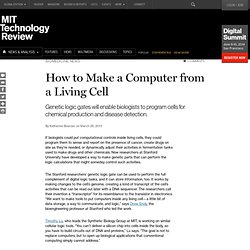
Now researchers at Stanford University have developed a way to make genetic parts that can perform the logic calculations that might someday control such activities. The Stanford researchers’ genetic logic gate can be used to perform the full complement of digital logic tasks, and it can store information, too. It works by making changes to the cell’s genome, creating a kind of transcript of the cell’s activities that can be read out later with a DNA sequencer.
The researchers call their invention a “transcriptor” for its resemblance to the transistor in electronics. Timothy Lu, who leads the Synthetic Biology Group at MIT, is working on similar cellular logic tools. Stanford creates biological transistors, the final step towards computers inside living cells. Bioengineers at Stanford University have created the first biological transistor made from genetic materials: DNA and RNA.
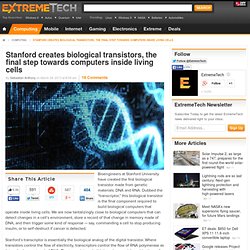
Dubbed the “transcriptor,” this biological transistor is the final component required to build biological computers that operate inside living cells. We are now tantalizingly close to biological computers that can detect changes in a cell’s environment, store a record of that change in memory made of DNA, and then trigger some kind of response — say, commanding a cell to stop producing insulin, or to self-destruct if cancer is detected.
Biological transistor enables computing within living cells. When Charles Babbage prototyped the first computing machine in the 19th century, he imagined using mechanical gears and latches to control information.
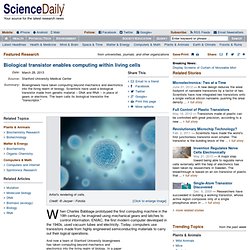
ENIAC, the first modern computer developed in the 1940s, used vacuum tubes and electricity. Today, computers use transistors made from highly engineered semiconducting materials to carry out their logical operations. And now a team of Stanford University bioengineers has taken computing beyond mechanics and electronics into the living realm of biology. Living Computers Possible with Biological Transistor. Biological transistor enables computing within living cells.
A team of Stanford University bioengineers has taken computing beyond mechanics and electronics into the living realm of biology.
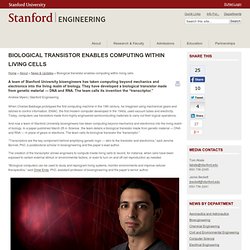
They have developed a biological transistor made from genetic material — DNA and RNA. The team calls its invention the “transcriptor.” Andrew Myers | Stanford Engineering When Charles Babbage prototyped the first computing machine in the 19th century, he imagined using mechanical gears and latches to control information. ENIAC, the first modern computer developed in the 1940s, used vacuum tubes and electricity. And now a team of Stanford University bioengineers has taken computing beyond mechanics and electronics into the living realm of biology. “Transcriptors are the key component behind amplifying genetic logic — akin to the transistor and electronics,” said Jerome Bonnet, PhD, a postdoctoral scholar in bioengineering and the paper’s lead author. Transcriptors & Boolean Integrase Logic (BIL) gates, explained. Drew Endy. Bio Drew Endy developed the world's first "fabless" genetic engineering teaching lab in the new Bioengineering program at Stanford and previously helped start the Biological Engineering major at MIT.

His Stanford research team develops genetically encoded computers and redesigns genomes. He co-founded the BioBricks Foundation as a public-benefit charity supporting free-to-use standards and technology that enable the engineering of biology (BioBricks.org). He co-organized the International Genetically Engineered Machines (iGEM.org) competition, the BIOFAB International Open Facility Advancing Biotechnology (BIOFAB.org), and Gen9, Inc. (Gen9bio.com). Research & Faculty. We believe that the most promising opportunities for discovery exist at the intersections of disciplines, and that the technologies of the next century will grow out of multidisciplinary partnerships.
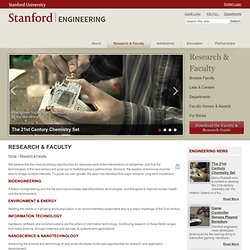
Similarly, the leaders of tomorrow must be able to bridge multiple interests. To guide our own growth, the dean has identified five major areas for long-term investment: A Computer Inside a Cell. For the first time, synthetic biologists have created a genetic device that mimics one of the widgets on which all of modern electronics is based, the three-terminal transistor.

Like standard electronic transistors, the new biological transistor is expected to work in many different biological circuit designs. Together with other advances in crafting genetic circuitry, that should make it easier for scientists to program cells to do everything from monitor pollutants and the progression of disease to turning on the output of medicines and biofuels. Researchers have already made impressive strides over the last decade in mimicking the behavior of electronic circuitry using DNA, RNA, and proteins. But often these devices tend to work only in the precise setting for which they were designed, such as turning up the expression of one particular gene in response to detecting a specific input signal.
Amplifying Genetic Logic Gates. Organisms must process information encoded via developmental and environmental signals to survive and reproduce.
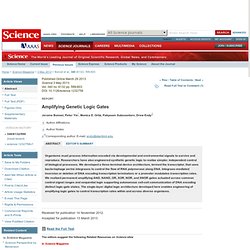
Researchers have also engineered synthetic genetic logic to realize simpler, independent control of biological processes. We developed a three-terminal device architecture, termed the transcriptor, that uses bacteriophage serine integrases to control the flow of RNA polymerase along DNA. Integrase-mediated inversion or deletion of DNA encoding transcription terminators or a promoter modulates transcription rates. We realized permanent amplifying AND, NAND, OR, XOR, NOR, and XNOR gates actuated across common control signal ranges and sequential logic supporting autonomous cell-cell communication of DNA encoding distinct logic-gate states. The single-layer digital logic architecture developed here enables engineering of amplifying logic gates to control transcription rates within and across diverse organisms.